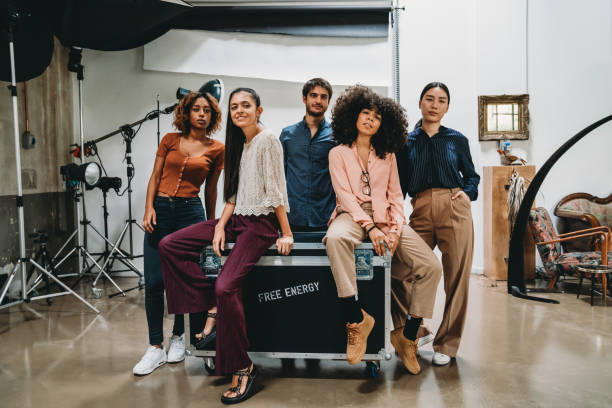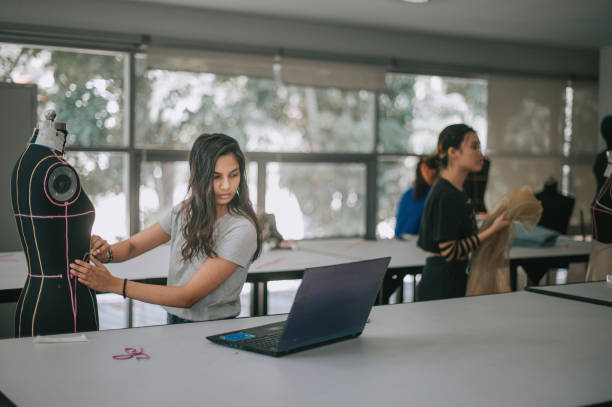What You’ll Learn in a Fashion Designing Course – A Complete Guide
Fashion designing is more than just sketching garments or following trends. It is a multifaceted discipline that blends creativity, technical skills, innovation, and business acumen. If you’ve ever wondered what you’ll actually learn in a fashion designing course, this blog post breaks it down for you in detail—whether you’re considering a diploma, undergraduate, or even short-term program.

Whether you’re planning to pursue a Fashion Designing Course in Delhi, Mumbai, or anywhere else, understanding the syllabus, skills, and career prospects will help you make an informed choice. Here’s everything you need to know.
🎨 1. Foundation in Fashion: Understanding the Basics
Before diving into fabrics and fashion shows, you’ll build a strong foundation in art and design.
Key Topics Covered:
Elements and Principles of Design: Learn the fundamentals of visual design—balance, contrast, rhythm, harmony, and proportion.
Fashion Illustration: Master the art of drawing fashion figures, poses, garments, and accessories.
Color Theory: Explore how colors influence fashion, mood, and perception.
Textile Science: Understand different types of fibers, yarns, weaves, and fabric finishes.
This phase is essential to help you think like a designer and build creative confidence.
✂️ 2. Garment Construction and Pattern Making
This is the heart of every fashion designing course. You’ll learn how to translate your sketches into real garments.
What You’ll Learn:
Pattern Drafting: Create basic blocks and convert them into stylish patterns.
Draping Techniques: Learn how to manipulate fabric on mannequins for 3D garment construction.
Sewing Techniques: Gain hands-on experience in stitching and tailoring.
Garment Finishing: Understand lining, hemming, zippers, buttons, and embellishments.
By the end of this phase, you’ll be able to design and construct your own outfits from scratch.
🧵 3. Textile & Fabric Study
Understanding materials is critical in fashion. This module helps you choose the right fabric for the right design.
Topics Include:
Natural vs synthetic fibers
Fabric behavior and fall
Surface ornamentation (embroidery, printing, dyeing)
Sustainable and eco-friendly textiles
You’ll also learn how to assess quality, texture, weight, and durability—important for designing functional and fashionable garments.
💡 4. Fashion History and Trend Analysis
Fashion doesn’t exist in a vacuum. It evolves with society, culture, and politics. This subject will teach you how to connect fashion with its context.
You Will Explore:
Fashion movements from the 20th and 21st centuries
Iconic designers and their impact (e.g., Coco Chanel, Alexander McQueen)
Indian traditional wear and regional textiles
Trend forecasting and research
This knowledge helps you stay relevant and design with meaning and originality.
💻 5. Fashion CAD (Computer-Aided Design)
Technology plays a huge role in modern fashion. In most fashion designing course, you’ll learn to use software that enhances design, communication, and production.
Software You Might Learn:
Adobe Illustrator & Photoshop (for flats, mood boards)
CorelDRAW (for vector-based design)
CLO 3D or Marvelous Designer (3D garment visualization)
TUKAcad or Optitex (pattern making)
Mastering these tools makes you job-ready in today’s digitized fashion industry.
🛍️ 6. Fashion Marketing and Merchandising
Designers must also understand how fashion reaches the consumer. This module blends creativity with business.
Skills Developed:
Fashion buying & retailing
Visual merchandising
Branding & positioning
Fashion PR and advertising
E-commerce and social media strategy
This is particularly useful if you plan to launch your own brand, work in retail, or take up a role in fashion marketing.
📸 7. Styling and Portfolio Development
Your personal style and presentation matter. Most fashion courses emphasize building a signature style and visual identity.
What You’ll Do:
Learn to style garments for shoots, shows, and campaigns
Curate a strong, professional fashion portfolio
Develop lookbooks, theme boards, and editorial layouts
Understand makeup, hairstyling, and accessory coordination
This portfolio is your most important asset when applying for internships, jobs, or launching your own label.
🎓 8. Internships, Projects & Fashion Shows
Practical exposure is often the most valuable part of a fashion designing course. Many institutes include internships, live projects, and shows as a compulsory part of the curriculum.
What You’ll Gain:
Work experience with brands, designers, or production units
Networking opportunities with industry professionals
Participation in fashion shows, exhibitions, and contests
Real-world understanding of design-to-delivery processes
Delhi, for example, being a fashion capital, provides access to major fashion events, trade fairs, and designer studios for students.
💼 9. Entrepreneurship and Fashion Business
If you’re planning to start your own fashion line, this module will be immensely helpful.
You’ll Learn About:
Business planning and budgeting
Legalities (licensing, trademarks)
Supply chain and vendor management
Pricing strategies
How to pitch to buyers or investors
Some courses even support student startups through incubation programs and mentorship.

📍 Where Can You Study Fashion Designing in Delhi?
Delhi offers some of the best fashion design education in India. Top institutes include:
National Institute of Fashion Technology (NIFT Delhi)
Pearl Academy
JD Institute of Fashion Technology
INIFD (International Institute of Fashion Design)
IIFT (Indian Institute of Fashion Technology)
These institutes offer diploma, undergraduate, and advanced diploma programs. Many also provide international exposure and exchange programs.
💸 What Does a Fashion Designing Course Cost?
Diploma/Short-Term Course: ₹1 lakh – ₹3 lakhs (1–2 years)
Bachelor’s Degree: ₹5 lakhs – ₹10 lakhs (3–4 years)
Advanced Programs: ₹10 lakhs and above (with global exchange or specialization)
💼 What Jobs Can You Get After a Fashion Designing Course?
Once you complete your course, you can explore careers such as:
Fashion Designer
Textile or Print Designer
Fashion Illustrator
CAD Designer
Fashion Stylist
Merchandiser
Costume Designer
Fashion Blogger/Influencer
Entrepreneur (Boutique/Label owner)
💡 Final Thoughts: Is a Fashion Designing Course Right for You?
If you love design, color, textiles, storytelling through clothing, and have an eye for style, a fashion designing course can be the perfect gateway to a dynamic, fulfilling career. You’ll not only learn to create garments but understand the art, science, and strategy behind fashion.
Fashion is not just about trends—it’s about vision, versatility, and value. And the right course will help you bring all three together in your unique design journey.